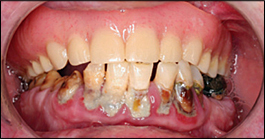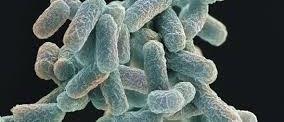Dental caries is simply defined as the decaying of the teeth. It can also be called dental decay. Dental caries or dental decay is a gradual disintegration of the teeth beginning from the tooth surface and progressing inwards. And it is usually initiated by microbial activity going on around the tooth surface. Dental caries include decay (loss) of the tooth enamel, loss of the dentine and loss of the root of the tooth. The loss of the tooth enamel is known as dental caries while the loss of the dentine is known as dentinal caries. Root caries is known as the loss of the root portion of the tooth.
Caries isthe general term used to describe the loss or decay of the dentine, root and enamel portions of the tooth caused by microbes. Dental caries are normally common on those parts of the teeth where the tooth brush make contact with the gum. Dental caries is one of the most common microbial diseases in man. The rate of dental infection is at its low in developed countries because of improved health care facilities but the reverse is the case in developing countries where healthcare is still poor. Dental caries is associated with several social and health challenges in humans, and some of these problems are briefly highlighted in this section.
PROBLEMS ASSOCIATED WITH DENTAL CARIES
- Dental caries bring about discomfort and tooth ache in the sufferer.
- It can result to endocarditis in affected individual especially when the causative agents involved become systemic or disseminated to other parts of the body.
- It is expensive to repair once it occurs.
- It can affect the speech of the individual, and it can also result to aesthetic deterioration.
Dental caries is caused by several species of bacteria especially bacteria in the genus Streptococcus, Lactobacillus, Actinomyces and Veillonella.These bacteria are acidogenic bacteria – because they ferment (breakdown) carbohydrates to form organic acids which initiate the process of tooth decay. Streptococcus mutans, S. sanguis, S. salivarius, S. milleri, S. sobrinus, Lactobacillus acidophilus, Veillonella species and Actinomyces odontolyticus (which all form part of the oral flora especially Streptococcus mutans) are the main bacterial species that cause dental caries in humans. These organisms are caryogenic in nature (i.e. they have high affinity for sugar especially sucrose – which they metabolize to cause dental infection in the tooth region).
Sugar beverages and sucrose are highly implicated in dental caries formation. The microorganisms implicated in caries formation in humans as aforementioned initiate the fermentation of sugar molecules; and this leads to the formation of acids (inclusive of lactic acid and acetic acid). The acid formed demineralizes or gradually degrades the enamel, root and dentine portion of the tooth – to cause caries. Caries formation occurs because these portions of the tooth where decay forms especially the enamel is very sensitive to pH; and a drop in the pH level of the region affected (due to increase in the acid content of the region) leads to the formation of a cavity.
The organic acids formed due to microbial degradation of sugar generally leads to the dissolution of tooth structures including the dentine, enamel and root or cementum. For caries to form, several factors in including time, a suitable substrate for optimal microbial growth (e.g. sucrose), and a susceptible tooth surface are vital for the formation of caries. The use of artificial tooth can also stimulate the development of caries in the tooth.
Streptococcus species especially S. mutans play a central role in caries formation; and this organism aside other streptococcal species such as S. sobrinus adhere strictly to the tooth enamel and they cause the accumulation of glycogen several months (e.g. about 24 months) after colonization. Glucose, fructose and sucrose are the important sugars formed by the organism due to the breakdown of carbohydrates.
Sucrose is the major stimulator of oral microbes especially S. mutans. The bacterium is able to form extracellular polysaccharides (EPS) in the presence of sucrose; and EPS is vital in the formation of biofilms on the tooth surface – as is obtainable in dental plaque formation. S. mutans has a high fermentative ability and they require sucrose to form organic acids such as lactic acids and acetic acids which leads to the dissolution of the tooth structure. Dental caries usually present clinical as the formation of a white-translucent lesion on the affected tooth surface. The use of dental probe and radiography can be used clinically to decipher the defect occurring in the affected area.
Microbiological analysis which includes the cultivation of samples from the affected area on growth media is usually employed in the laboratory diagnosis of dental caries. Culture helps in the isolation and identification of bacterial species responsible for the caries formation.
Since the major cause of caries is due to the consumption of fermentable sugars or carbohydrates (especially sucrose), it is advisable to take caution in eating food that contain such substances as sucrose. Decreasing the growth of Streptococcus species (especially S. mutans) by avoiding the consumption of high-sucrose food or beverages is necessary for the prevention of caries formation. Regular visits to dentists will also help to contain some dental infection such as caries.
References
Barrett J.T (1998). Microbiology and Immunology Concepts. Philadelphia, PA: Lippincott-Raven Publishers. USA.
Beck, J. D., Slade, G. and Offenbacher, S. (2000). Oral disease, cardiovascular disease and systemic inflammation. Periodontol, 23, 110-20.
Beers M.H., Porter R.S., Jones T.V., Kaplan J.L and Berkwits M (2006). The Merck Manual of Diagnosis and Therapy. Eighteenth edition. Merck & Co., Inc, USA.
Brooks G.F., Butel J.S and Morse S.A (2004). Medical Microbiology, 23rd edition. McGraw Hill Publishers. USA.
Champoux J.J, Neidhardt F.C, Drew W.L and Plorde J.J (2004). Sherris Medical Microbiology: An Introduction to Infectious Diseases. 4th edition. McGraw Hill Companies Inc, USA.
Davey M.E and O’toole G.A (2000). Microbial biofilms: from ecology to molecular genetics. Microbiol. Mol. Biol. Rev, 64, 847-867.
Gillespie S.H and Bamford K.B (2012). Medical Microbiology and Infection at a glance. 4th edition. Wiley-Blackwell Publishers, UK.
Jenstch, H., Pornowski, R., Kundi, G. and Gocke, R. (2003). Treatment of gingivitis with hyaluronan. J. Clin. Periodontol.,30, 159-164.
Mayooran B, Robin S and John R.T (2000). Dental caries is a preventable infectious disease. Aust. Dent. J, 45, 235-245.
Trahan L.X (1995). A review of its action on mutans streptococci and dental plaque–its clinical significance. Int. Dent. J, 45, 77-92.
Warren L (2008). Review of Medical Microbiology and Immunology. Tenth edition. McGraw Hill Companies Inc, USA.
Wilson B. A, Salyers A.A, Whitt D.D and Winkler M.E (2011). Bacterial Pathogenesis: A molecular Approach. Third edition. American Society of Microbiology Press, USA.
Discover more from #1 Microbiology Resource Hub
Subscribe to get the latest posts to your email.



